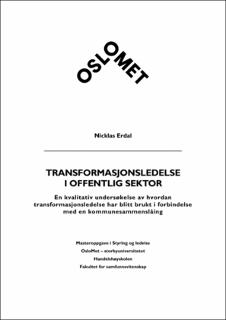| dc.description.abstract | This Master thesis research shows how transformational leadership was being used by leaders in the public sector according to a municipality merge. The municipal structural reform in Norway was agreed upon by Parliament in 2014 and acted in 2020. This Master thesis does a closer review on how leaders in a chosen municipality worked and influenced the processes in advance, during and after the merge. Initially, I developed a main research problem, which was: How was transformational leadership used in the municipality merge? Due to this, I further developed five research questions.
This is a qualitative research, where the method I have used is interviews with six chosen leaders who all work in different departments at the municipality. Since I have chosen one specific municipality, this project is also a case study. Data from the interviews is categorized, analyzed, and then represented. The theory used as a premise for my data collection, is theories on transformational leadership, municipality history in Norway, the municipal structural reform and leadership in the public sector both generally and specifically.
Thesis statements of this study is that transformational leadership is highly relevant in the public sector, regardless of the municipality merge. The leaders all show how they use elements of transformational leadership style on a daily basis. When it comes to the merge and the processes this led to, the leaders were more than regularly aware of their influence as role models. They started the processes two years in advance of the merge; using workshops, podcasts, and events where co-workers from both the municipalities met and collaborated laterally. They also got aware of how their leadership style influenced the group processes and tried with great effort to achieve a good and supportive relation to their co-workers. The leaders emphasized the grade of independency they were granted during the processes, which abled them to include their co-workers and take on the tasks in different and the most creative ways. The main goal in advance was for the co-workers to get to know each other and start collaborating, but by which method the leaders could choose freely. The independency was also important due to the work they were imposed to do according to the new municipality vision.
The municipality merge acted in January 2020. In March, the pandemic took all their focus and led to a shut down. The new municipality was then nearly 50 days old. The leaders report that due to the pandemic, the processes they were supposed to initiate at this point, were all shelved. Up until spring 2022, the municipality has mainly focused on pandemic tasks. According to the situation, this project does not have research results on how the merge went. All the processes the leaders had planned for after the merge, just got started. Regardless, a main thesis statement is the high relevance of transformational leadership in public sector. | en_US |
